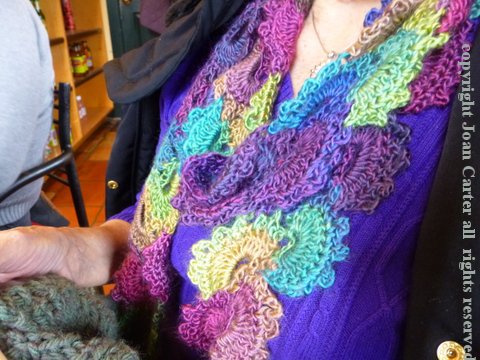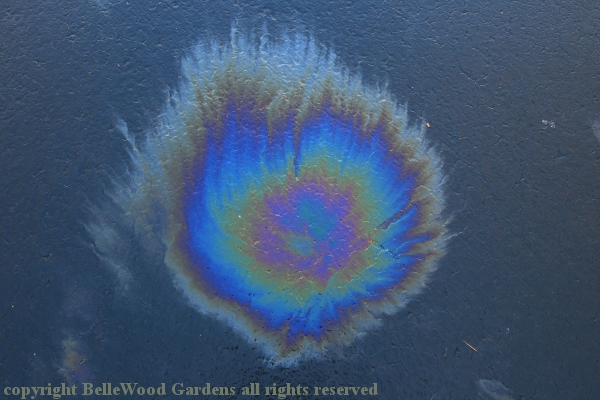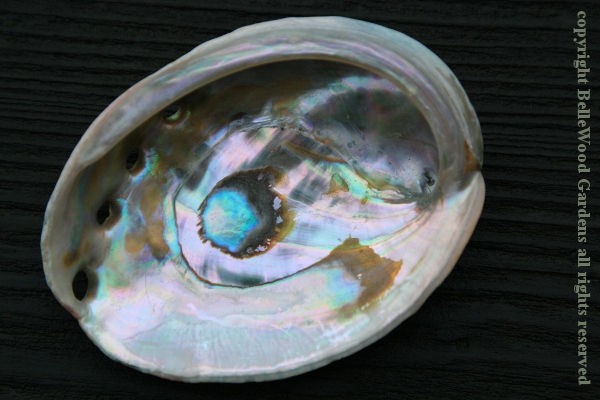
.
If you have any comments, observations, or questions about what you read here, remember you can always Contact Me
All content included on this site such as text, graphics and images is protected by U.S and international copyright law.
The compilation of all content on this site is the exclusive property of the site copyright holder.
Last week of the year. I'm off
to the Wednesday morning knitting group at the Bridge Cafe.

One of my stitch sisters is wearing a scarf
with all the colors of a soap bubble. Sort of.
The colors of Joanne's scarf are from pigment. Most of the colors we see in nature - green plants, for example - are the result of substances that selectively absorb light at some wavelengths and reflect it in others. Plants look green because chlorophyll absorbs and reflects all wavelengths of light except green.
Wikipedia has this to say: "Biological pigments, also known simply as pigments or biochromes are substances produced by living organisms that have a color resulting from selective color absorption. Biological pigments include plant pigments and flower pigments. Many biological structures, such as skin, eyes, feathers, fur and hair contain pigments such as melanin in specialized cells called chromatophores. Pigment color differs from structural color in that it is the same for all viewing angles, whereas structural color is the result of selective reflection or iridescence, usually because of multilayer structures. For example, butterfly wings typically contain structural color, although many butterflies have cells that contain pigment as well."
Pigment is one thing. Then there are structural colors, created by an optical effect (such as interference, refraction, or diffraction), which are different. Rather than by a pigment, the arrangement of physical structures interacting with light produce a particular color.
Iridescence is the magical patterning of nature where colors that do not exist as pigment are revealed in a lustrous rainbowlike play of color caused by differential refraction of light waves.

Think you, of a rainbow, wherein droplets of water break the sun's light
into separate colors: red to orange and yellow, green to blue and violet.

A prism's shifting thickness of glass does do the same,
and breaks the light apart into its component colors.

What then, a spreading rainbow from a drop of oil on pavement? It cannot mix with water
and spreads, its film thickest in the center of the patch and thinnest at the periphery.
Iridescence occurs when some of the light reflects upward from the top of the oil film and and the rest of the light goes through, to be reflected from the bottom surface. The two sets of reflected waves travel back upwards in the same direction. But the bottom-reflected waves travelled a little further. The two sets of waves are out of phase.

We see this abalone shell with its mother-of-pearl as iridescent. The strong nacreous colors are the result of two mechanisms: a fine-scale diffraction grating structure which splits the light, and also the uniform stacking of thin crystalline nacreous layers below the surface of the shell resulting in interference effects that contribute to the iridescent colors.

And the incredibly precise arrangement of colors
on a peacock's tail are different yet.
Not pigmentation. Not thin film iridescence. Researchers found that the colors are produced by tiny, intricate two-dimensional crystal-like structures. Slight alterations in the spacing of these microscopic structures cause different wavelengths of light to be filtered and reflected, creating the feathers' many different iridescent hues.

A peacock's breast feather on some black velvet fabric.
Notice the "grain" of the fabric, parallel to the feather's quill.

Same feather, same fabric. Notice the feather is at right angles
to the fabric, 90 degrees to the sunlight. It now appears vivid blue.
Patterns of nature. Shall we call it science? Or magic? Or, simply say, "It's beautiful."
Back to Top
Back to December 2016
Back to the main Diary Page